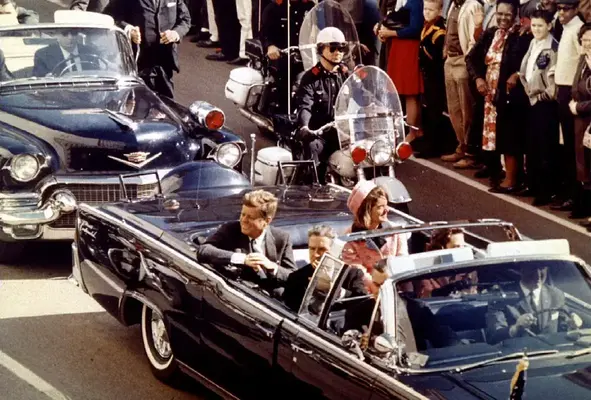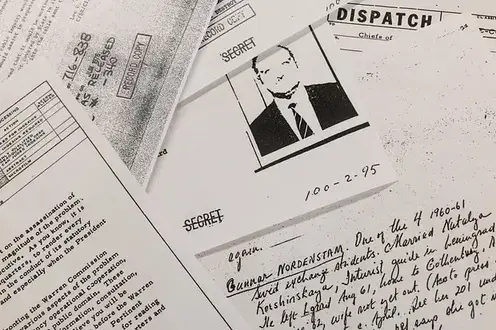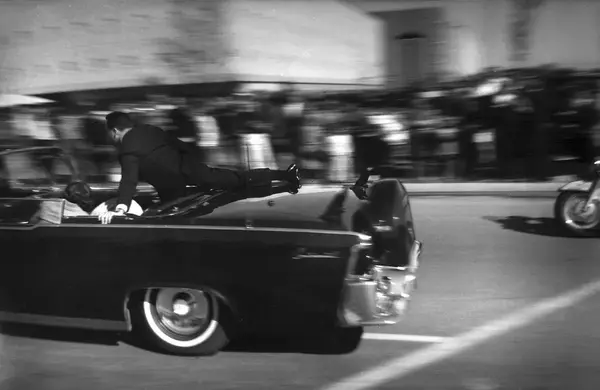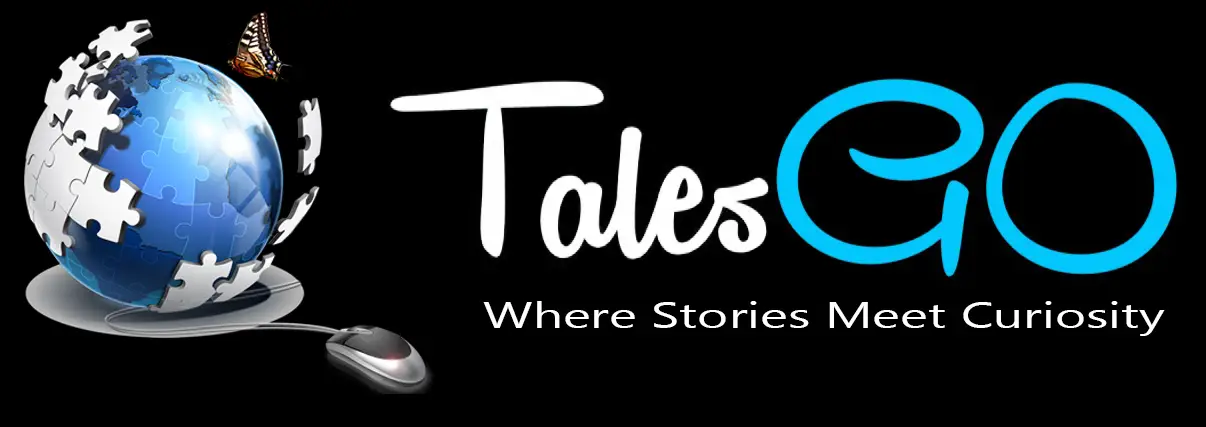New Revelations: Declassified Files on the Kennedy Assassination and Their Political Consequences
On March 18, 2025, following an order from former President Donald Trump, the National Archives of the United States released a massive collection of previously classified documents related to the assassinations of President John F. Kennedy, his brother Robert Kennedy, and civil rights leader Martin Luther King Jr. 🇺🇸
These newly declassified files—first noticed by Lenta.ru correspondent—shed new light on the role of the Soviet KGB and diplomatic actors in the events surrounding Kennedy’s assassination. They also reveal why American intelligence agencies were concerned about the wave of conspiracy theories associated with the case, particularly those involving the Cold War context. 🕊️
While the release of these documents received relatively little attention in the Western press, their contents provide invaluable material for further investigation. Many details underscore how deeply the Cold War between the United States and the Soviet Union was intertwined with the official narrative of Kennedy’s assassination. 🇷🇺

What Was Revealed in the Recently Released Kennedy Files?
The National Archives of the United States has released over 2,000 previously classified documents related to the Kennedy case. According to Tulsi Gabbard, Director of the National Intelligence Agency, the archive now includes over 80,000 pages of material, some of which may alter the public perception of one of the most tragic and mysterious political murders in America’s history.
Trump’s push to declassify Kennedy files began in 2017, but intelligence agencies blocked full disclosure at the time, citing national security concerns. Now, nearly 99% of the entire archive is accessible to the public, unveiling a staggering collection of more than six million documents. 📚
According to Associated Press (AP), about 3,000 files remain partially or entirely classified. Additionally, in recent years, another 2,400 documents related to the case were released, raising new questions about the secrets they may contain and when (or if) they will ever be published.
Why Did the U.S. Fear Conspiracy Theories After Kennedy’s Assassination?
The newly released documents reveal that American intelligence agencies were deeply concerned about the international reputation of the U.S. following the assassination of President Kennedy. As a result, they meticulously monitored foreign publications related to conspiracy theories surrounding the event. There were fears that such theories could undermine the official narrative and weaken America’s global standing during the escalation of the Cold War. 🌍
The Soviet Union Passed Intelligence on Kennedy’s Killer to the U.S.
One of the most intriguing revelations in the newly declassified files is that the Soviet Union provided intelligence about Lee Harvey Oswald to U.S. authorities, offering crucial context for the events surrounding Kennedy’s assassination. These materials show that the KGB closely monitored Oswald during his time in the Soviet Union between 1959 and 1962. 📜
The Soviet Union cut all intelligence ties with Oswald, citing his unstable personality and difficult nature—making him unsuitable for covert operations. They also shared details of his strained relationship with Marina Priskova, his Russian wife. 🇷🇺❤️
The Hidden Document and Possible Soviet Involvement in the Assassination
The CIA has always been an object of intrigue, and recently released files suggest that the Central Intelligence Agency of the United States and Australian intelligence agencies attempted to conceal a document linking the USSR to the assassination of President Kennedy. The uncovering of this hidden document raises serious questions about what the U.S. knew and deliberately withheld from the public for decades. 🕵️♂️

Could the Soviet Union Have Warned the U.S. About Oswald’s Plot?
Recent materials indicate that the Soviet Union may have known in advance about Lee Harvey Oswald’s plans to kill Kennedy. A series of letters, sent between 1977 and 1978 by Sergey Chernokhon, a mysterious individual, suggest that a warning may have been issued to U.S. authorities. The authenticity and implications of these statements remain unclear, but they add another layer of intrigue to the Cold War narrative. 📜✉️
KGB Agent Reveals Key Details About Kennedy’s Assassination
A recently declassified CIA memorandum sheds light on the interaction between KGB agent Yuri Nosenko and U.S. authorities, during which he discussed Oswald’s life in the Soviet Union. This revelation suggests that Oswald may have been looking for escape routes following the planned attack, even attempting to secure a Soviet visa. 🕶️📋
Moreover, there is speculation that Oswald may have been in contact with KGB officer Valery Kostikov, a diplomat working in the consular section in Mexico City, who was responsible for overseeing the Soviet Union’s relationships with Central American communist groups. 🌍
Why Does the Kennedy Assassination Remain Politically Relevant Today?
The political ramifications of these newly released documents extend beyond historical interest. In an era when international relations and intelligence gathering continue to shape global politics, understanding the inner workings of spy operations may shed light on contemporary political dynamics. 🇺🇸🤝🇷🇺
The Kennedy assassination remains one of the most significant political events in U.S. history, and ongoing debates about conspiracy theories and government transparency will have a profound impact on future generations. These revelations serve as a reminder of the complex network of political maneuvers, espionage operations, and international diplomacy that defined the Cold War era and continue to influence U.S. foreign policy and intelligence practices today. 🌍
Interesting Facts:
- Initial Findings: After John F. Kennedy’s assassination in 1963, the investigation attracted worldwide attention. The official investigation concluded that Lee Harvey Oswald was the lone gunman. However, many remain skeptical, suspecting a conspiracy involving other participants.
- KGB Secret Files: Recently declassified documents reveal that the Soviet Union was monitoring Lee Harvey Oswald during his stay in the USSR from 1959 to 1962. The KGB was concerned about his unstable behavior and explicitly stated that Oswald was not their agent.
- Castro’s Influence: Some theories suggest that the assassination was linked to Kennedy’s political stance towards Cuba. Fidel Castro, the leader of Cuba, repeatedly stated that he saw U.S. policy as a threat to his country, fueling speculation about potential Cuban or even Cuban government involvement in the assassination.
- 30 Years Later: In 1991, nearly three decades after the assassination, Oliver Stone’s documentary film JFK sparked numerous conspiracy theories and reignited questions about the true circumstances of the tragedy. The film accused both American and international forces of orchestrating the murder.
- Secrecy Around Information: In 1992, a decision was made to release previously classified documents related to the Kennedy assassination. However, many materials remain sealed, continuing to fuel theories about hidden truths.

Real Eyewitness Accounts:
- Harry Walker (Security Officer): On the day of the assassination, Harry Walker, a security officer accompanying John F. Kennedy, was seated in the back of the car next to the president. He later recalled hearing the gunshots but not realizing what had happened right away. He described the moment as “a deafening sound, followed by total chaos.” His memories provide insight into the immediate reaction of Kennedy’s inner circle.
- Penny Parker (Journalist): Penny Parker, a journalist covering Kennedy’s assassination, said that at first, no one understood what had happened after the shots rang out. She remembered the panic surrounding her, with a pervasive sense of fear in the air as no one knew who was responsible for the shooting.
- Dallas Mayor Edward Clarke: Edward Clarke, the mayor of Dallas, was inside a government building when the shots were fired. In his recollections, he wrote that when the bullets were heard, there was an eerie silence and confusion in the air. However, once it was confirmed that Kennedy was dead, the city fell into a profound state of mourning.
Shocking Words from Famous Politicians:
- Lyndon B. Johnson (36th U.S. President): In the hours following Kennedy’s assassination, Lyndon B. Johnson, who succeeded Kennedy, said: “I don’t know who killed him, but someone had a vested interest in it.” This comment attracted the attention of many conspiracy theorists and historians, hinting at possible dark forces behind the crime.
- Fidel Castro: In a 2000 interview, Fidel Castro, the former leader of Cuba, stated: “We did not kill John Kennedy. It was too obvious and untimely to be beneficial to Cuba. However, we never forgot how he tried to destroy our revolution.” This remark sparked debates over possible indirect involvement by Cuba.
- Richard Nixon (37th U.S. President): In a 1990 interview, former president Richard Nixon said: “We may never know the whole truth about what happened that day. But one thing I know for certain— the world changed in that moment. And we all became part of that change.”
- Mikhail Gorbachev: In a 1987 interview, Mikhail Gorbachev, then General Secretary of the Communist Party of the Soviet Union, stated that the USSR had no involvement in Kennedy’s assassination. However, according to him, Kennedy’s death significantly altered the atmosphere in the world, creating tension both in U.S. politics and international relations.

1. The Missing Bullet Theory:
One of the most shocking aspects of the JFK assassination was the “magic bullet” theory. This theory suggests that one single bullet caused several injuries to both President Kennedy and Texas Governor John Connally, who was riding with him in the car. The idea that one bullet could simultaneously wound both men in such different areas of the body has been widely debated. Some critics argue it’s highly improbable, while others claim it’s evidence of a broader conspiracy to cover up the truth.
2. The Sudden Silence:
When the shots rang out in Dealey Plaza, there was an eerie and unexpected silence that followed. Onlookers reported hearing the shots, but immediately after, the atmosphere turned unusually quiet. The sudden stillness was unsettling as crowds began to comprehend the gravity of the situation. People were frozen in shock, unable to grasp what had just happened.
3. Jackie Kennedy’s Reaction:
Jacqueline Kennedy, the First Lady, had a deeply shocking reaction after the assassination. Witnesses reported that after the fatal shots, she immediately turned toward her husband, and it appeared as though she tried to collect pieces of his skull. In a deeply unsettling moment of vulnerability, she became covered in her husband’s blood. The iconic image of her climbing onto the back of the car after the shooting has been etched into the collective memory of the nation.
4. The ‘Second Shooter’ Sightings:
Though Lee Harvey Oswald was officially deemed the lone assassin, many people claimed they saw a second shooter on the grassy knoll in Dealey Plaza. Some witnesses even reported seeing someone running away from the scene after the shots were fired, fueling further speculation about conspiracy theories. Despite investigations that have failed to confirm these claims, the mystery of a second shooter remains a topic of intrigue and disbelief.
5. The Secrecy Around the Autopsy:
The autopsy conducted on President Kennedy’s body was shrouded in secrecy and controversy. The body was quickly removed from Dallas and flown to Bethesda Naval Hospital in Maryland, bypassing the usual procedures for a homicide investigation. Furthermore, multiple discrepancies were found in the autopsy reports, including contradictions in the location of the bullet wounds and the trajectory of the bullets, sparking rumors of a cover-up.
6. The Mysterious Umbrella Man:
In the crowds gathered in Dealey Plaza, one particular figure has long fascinated conspiracy theorists. A man known as the “Umbrella Man” appeared on the scene with an umbrella, which was highly unusual given the clear weather. Some speculated that the umbrella was a signal or a concealed weapon used to distract or even assist in the shooting. His identity remains one of the most enduring mysteries from the day of the assassination.
7. The Secret Service’s Absence of Protection:
On the day of the assassination, there were several lapses in the usual security protocols. JFK’s motorcade was not as heavily guarded as it had been on previous occasions, and Secret Service agents were positioned further away from the president than was typical. It has been widely discussed that if there had been a more comprehensive security presence, the shooting could have been prevented.
8. The Warren Commission’s Flaws:
The official investigation into President Kennedy’s assassination, known as the Warren Commission, has been criticized for numerous discrepancies and incomplete evidence. Many critics have pointed out that vital pieces of information were overlooked, witnesses were ignored, and some of the evidence was even destroyed or tampered with. This has fueled long-standing doubts about the authenticity of the official narrative.
9. Oswald’s Calmness After the Assassination:
Lee Harvey Oswald was captured only hours after the assassination, but what was most chilling was his calm demeanor when arrested. Witnesses described Oswald as eerily composed, even as police confronted him. Instead of showing any emotion or panic, he reportedly said, “I’m just a patsy,” a statement that has only added to conspiracy theories and suspicions about whether Oswald acted alone.
10. The Killing of Officer Tippit:
Shortly after the assassination, Dallas police officer J.D. Tippit was shot and killed by Lee Harvey Oswald in what appeared to be an execution-style killing. The shooting occurred in the Oak Cliff neighborhood of Dallas, and Oswald was arrested shortly afterward. The fact that Tippit’s murder was quickly attributed to Oswald, yet still remains part of the broader mystery surrounding the events of that day, has added layers of intrigue to the case.
These shocking details contribute to the ongoing mystery and suspicion surrounding John F. Kennedy’s assassination. The complexity of the events, the conflicting accounts, and the dramatic aftermath continue to fuel debates and conspiracy theories, ensuring that the truth about that fateful day remains one of the most enduring mysteries in American history.
Conclusion
The declassification of these key documents brings us one step closer to understanding the full extent of the events surrounding President John F. Kennedy’s assassination. However, many questions remain unanswered. Public curiosity about the true circumstances of the assassination is unlikely to fade anytime soon, especially with the tantalizing revelations about the Cold War and international politics now available for researchers and the general public. 📖

